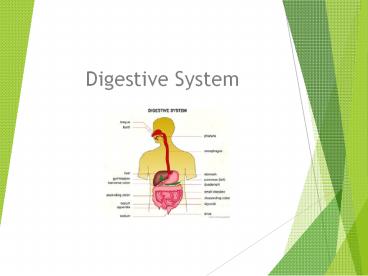Digestive System - PowerPoint PPT Presentation
1 / 15
Title:
Digestive System
Description:
... Chew Tear Grind Mash Mix Chemical Enzymatic reactions to improve digestion of Carbohydrates Proteins Lipids Digestive System Organization Gastrointestinal ... – PowerPoint PPT presentation
Number of Views:120
Avg rating:3.0/5.0
Title: Digestive System
1
- Digestive System
2
Digestion
- Phases
- Ingestion
- Movement
- Mechanical and Chemical Digestion
- Absorption
- Elimination
3
Digestion
- Types
- Mechanical (physical)
- Chew
- Tear
- Grind
- Mash
- Mix
- Chemical
- Enzymatic reactions to improve digestion of
- Carbohydrates
- Proteins
- Lipids
4
Digestive System Organization
- Gastrointestinal (Gl) tract
- Tube within a tube
- Direct link/path between organs
- Structures
- Mouth
- Pharynx
- Esophagus
- Stomach
- Small intestine
- Large Intestine
- Rectum
5
Mouth
- Teeth mechanically break down food into small
pieces. Tongue mixes food with saliva (contains
amylase, which helps break down starch).
- Epiglottis is a flap-like structure at the back
of the throat that closes over the trachea
preventing food from entering it.
6
Esophagus
- Approximately 10 long
- Functions include
- Secrete mucus
- Moves food from the throat to the stomach using
muscle movement called peristalsis
7
Stomach
- J-shaped muscular bag that stores the food you
eat, breaks it down into tiny pieces. - Mixes food with digestive juices that contain
enzymes to break down proteins and lipids. - Acid in the stomach kills bacteria.
- Food found in the stomach is called chyme.
8
Small Intestine
- Small intestines are roughly 7 meters (22.9 ft)
long - Lining of intestine walls has finger-like
projections called villi, to increase surface
area. - The villi are covered in microvilli which further
increases surface area for absorption.
9
Small Intestine
- Nutrients from the food pass into the bloodstream
through the small intestine walls. - Absorbs
- 80 ingested water
- Vitamins
- Minerals
- Carbohydrates
- Proteins
- Lipids
- Secretes digestive enzymes
10
Large Intestine
- About 5 feet long
- Accepts what small intestines dont absorb
- Rectum (short term storage which holds feces
before it is expelled).
11
Large Intestine
- Functions
- The major function of the large intestine is to
absorb water from the remaining indigestible food
matter and transmit the useless waste material
from the body. - Appendix- storehouse for good bacteria
- Ascending Colon-carries feces from the cecum
superiorly along the right side of our abdominal
cavity to the transverse colon. - Transverse Colon- longest region of the colon and
is located between the ascending colon and
descending colon. - Descending Colon-store the remains of digested
food that will be emptied into the rectum.
12
Accessory Organs
- Not part of the path of food, but play a critical
role.
- Include Liver, gall bladder, and pancreas
13
Liver
- Directly affects digestion by producing bile
- Bile helps digest fat
- filters out toxins and waste including drugs and
alcohol
14
Gall Bladder
- Stores bile from the liver, releases it into the
small intestine. - Fatty diets can cause gallstones
15
Pancreas
- Produces digestive enzymes to digest fats,
carbohydrates and proteins - Regulates blood sugar by producing insulin































